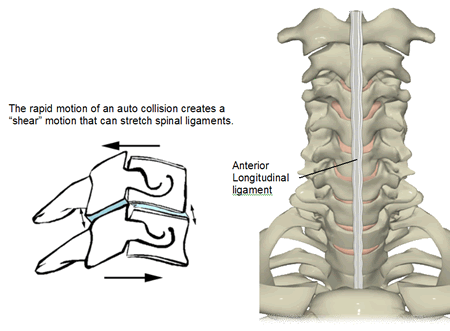This study is important, because it shows that the ligaments of the cervical spine are weakened after even a “minor” auto collision. This weakening of the integrity of the cervical spine can result in abnormal motion of the spine, pain, and premature degeneration of the vertebral joints – more commonly known as osteoarthritis.
After years of study, it is clear that the spinal ligaments can be stretched or torn during an auto collision. Previous studies have shown that the anterior longitudinal ligaments, the transverse ligaments, and the facet capsules can be damaged, even in “minor” crashes.
The scientific consensus is this: during an auto collision, the individual vertebrae of the spine move so rapidly and so extremely, the ligaments that hold the spine together are sprained.
A new study from Yale University has taken an important new step in understanding the exact nature of these injuries. First, the researchers started with six cadaver spines that they had previously exposed to simulated rear end collisions. They took these spines apart and tested the failure point of each of the individual ligaments. They then compared the failure rate of the whiplash spinal ligaments to previously collected data on normal, non-injured spines.
The authors studied four different characteristics of the ligaments: failure force, elongation, energy absorbed, and stiffness. The data from the whiplash-exposed ligaments was then compared to the control ligaments.
The authors found that the whiplash ligaments were significantly weaker than the control specimens:
“The present study determined the dynamic failure properties of whiplash-exposed human cervical spine ligaments and compared the results with previously reported control data. Significant decreases in ligament strength were observed following whiplash, supporting the ligament-injury hypothesis of whiplash syndrome. Clinical studies, which have documented pain relief in whiplash patients following nerve block and radiofrequency ablation of facet joint afferents provide support for the present results which indicate whiplash loading causes decreased ligament strength.”
The study provides a suggested sequence of events that may occur after injury to the ligaments that can cause chronic pain and disability after a collision:
- The violent stretching of the ligaments causes subfailure injuries to the ligaments and nerve receptors in the ligaments.
- This weakening of the ligaments may lead to altered joint motion and loading patterns, compressing the joint tissues.
- This compression can result in inflammation, pain, and accelerated degeneration of the joint tissue, resulting in osteoarthritis of the neck.
This study is the first to show that the individual ligaments of the spine are weakened after a whiplash-type motion. Clinically, it is important to carefully measure range of motion and to use flexion/extension radiographs in these patients to help pinpoint those areas of the spine that have been injured.
Tominaga Y, Ndu AB, Coe MP, et al. Neck ligament strength is decreased following whiplash trauma. BMC Musculoskeletal Disorders 2006;7:103.